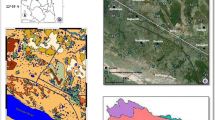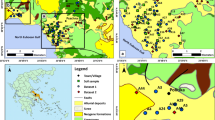Abstract
Groundwater of an aquifer located in the vicinity of a large coal washery near Zarand City, Iran consists of two hydrochemically differing facies, which have been informally designated as groundwater (A) and groundwater (B). Groundwater (A) is native, brackish in composition and is characterized by Na+ > Mg2+ > Ca2+ > K+ and SO4 2− > HCO3 − > Cl− > NO3 −. Spearman’s rank correlation coefficient matrices, factor analysis data, and values of chloro-alkaline indices, C ratio and Na+/Cl− molar ratio indicate that in the groundwater (A), the ionic load of Ca2+, Mg2+, Na+, K+, SO4 2− and HCO3 − is derived essentially from weathering of both carbonates and aluminosilicates and direct cation and reverse cation–anion exchange reactions. Groundwater (B) is the polluted variant of the groundwater (A), brackish to saline in composition, and unlike the groundwater (A), consists of HCO3 − as the dominant anion. In comparison with the groundwater (A), the groundwater (B) contains higher concentrations of all ions, and its average ionic load (av. = 59.74 me/L) is 1.43 times higher than that of the groundwater (A) (av. = 41.54 me/L). Additional concentrations of Ca2+, Mg2+, K+, SO4 2−, Cl− and HCO3 − in the groundwater (B) are provided mainly by downward infiltrating water from the coal washery tailings pond and reverse cation–anion exchange reaction between tailings pond water and exchanger of the aquifer matrix during non-conservative mixing process of groundwater (A) and tailings pond water. Certain additional concentrations of Na+, K+ and NO3 − in the groundwater (B) are provided by other anthropogenic sources. Quality wise, both groundwaters are marginally suitable for cultivation of salt-tolerant crops only.







Similar content being viewed by others
References
Amery H, Dastanpour M (2010) Stratigraphy and paleontology of Trilobites in Kuhbanan Formation in the Akbar-Abad section (North of Kerman). J Sci Islam Repub Iran 21(1):37–42
APHA (1995) Standard methods for the examination of water and waste water, 19th edn. American Public Health Association, Washington DC
Ayers RS, Wascot DW (1985) Water quality for irrigation. FAC Irrigation and Drainage Paper 20 Rev 1 FAO, Rome
Baghvand A, Nasrabadi T, Nabi Bidhendi GR et al (2010) Groundwater quality degradation of an Iran central desert. Desalination 260:267–275
Berner EK, Berner RA (1987) The global water cycle: geochemistry and environment. Prentice-Hall, Englewood Cliffs
Bower H (1978) Groundwater hydrology. McGraw-Hill Inc, New York
Brown GH, Sharp MJ, Tranter M (1996) Subglacial chemical erosion: seasonal variations in solute provenance, Haunt Glacier d’Arolla, Switzerland. Ann Glaciol 22:25–31
Cardona A, Carrillo Rivera JJ, Huizar-A’lvarez R, Graniel-Castro E (2004) Salinization in coastal aquifers of arid zones: an example from Santo Domingo, Baja California Sur, Mexico. Environ Geol 45:350–366
Carling M, Hammar M (1995) Nitrogen metabolism and leakage from pit latrines. University of Ludea. Report 1995, 020E, Ludea, Sweden
Cerling TE, Pederson BL, Damm KLV (1989) Sodium calcium ion exchange in the weathering of shales: implication for global weathering budgets. Geology 17:552–554
Chebotarev II (1955) Metamorphism of natural waters in the crust of weathering. Geochim Cosmochim Acta 8: 22–48,137–170,198–212
Davis NS, De Wiest JMR (1967) Hydrology, Chap. 3. Wiley, New York, p 463
Doneen LD (1964) Notes on water quality in agriculture. Water science and engineering paper, 4001, Dept of water Science and Engineering, University of California
Eaton FM (1950) Significance of carbonates in irrigation waters. Soil Sci 39:123–133
Ellaway M, Finlayson B, Webb J (1999) The impact of land clearance on Karst groundwater: a case study from Buchan, Victoria, Australia. In: Drew Hotzl D (ed) Karst hydrogeology and human activities. A.A. Balkema, Rotterdam, pp 66–68
Fisher RS, Mullican WF (1997) Hydrochemical evolution of sodium sulfate and sodium chloride groundwater beneath the Northern Chihuahuan desert, Trans-Pecos, Texas, USA. Hydrogeol J 10:455–474
Freez RA, Cherry JA (1979) Groundwater. Prentice Hall, Englewood Cliffs
Gibbs RJ (1970) Mechanism controlling world water chemistry. Science 170:1088–1090
Han G, Liu CQ (2004) Water chemistry controlled by carbonate dissolution: a study of the river waters draining Karst-dominated terrain, Guizhou Province, China. Chem Geol 204:1–21
Jalali M (2007) Assessment of the chemical component of Famenin groundwater, Western Iran. Environ Geochem Health 29:357–374
Jalali M (2009) Geochemistry characterization of groundwater in an agricultural area of Razan, Hamadan, Iran. Environ Geol 56:1479–1488
Jeong CH (2001) Effect of land use and urbanization on hydrochemistry and contamination of groundwater from Taejon area. Korea J Hydrol 253(1–4):194–210
Kelley WP (1951) Alkali soils—their formation properties and reclamation. Reinhold Publishing Corp, New York, pp 124–128
Kelley WP, Brown SM, Leibig GI Jr (1940) Chemical effects of saline irrigation water on soils. Soil Sci 49:95–107
Kumar M, Ramanathan AL, Rao MS, Kumar B (2006) Identification and evaluation of hydrochemical process in the groundwater environment of Delhi, India. Environ Geol. doi:10.1007/500254-006-0275-4
Lloyd JW, Heathcoat JA (1985) Natural inorganic hydrochemistry in relation to groundwater: an introduction. Oxford University Press, New York
Mandel S, Shiftan ZL (1981) Groundwater resources investigation and development. Academic Press, New York
Manjusree TM, Joseph S, Thomas J (2009) Hydrogeochemistry and groundwater quality in the coastal sandy clay aquifers of Alappuzha district, Kerala. J Geol Soc India 74(4):459–468
Margaritz M, Nadler A, Koyumdjisky Dan N (1981) The use of Na/Cl ratio to trace solute sources in a semiarid zone. Wat Resour Res 17:602–608
Meybeck M (1987) Global chemical weathering of surficial rocks estimated from river dissolved salts. Am J Sci 287:401–428
Min JH, Yun ST, Kim K, Kim HS, Kim DJ (2003) Geologic controls on the chemical behaviors of nitrate in riverside alluvial aquifers, Korea. Hydrol Proc 17:1197–1211
Mondal NC, Singh VP, Singh VS, Saxena VK (2010) Determining the interaction between groundwater and saline water through groundwater major ion chemistry. J Hydrol 388(1–2):100–111
Piper AM (1944) A graphical procedure in the chemical interpretation of groundwater analysis. Trans Am Geophys Union 25:914–928
Piper AM (1953) A graphical procedure in the geochemical interpretation of water analyses. USGS Ground water Note 12, p 63
Raghunath HM (2007) Groundwater, Chap. 4. New Age International (p) Limited, p 504
Raju NJ, Prahalad R, Dey S (2009) Groundwater quality in the lower Varuna River Basin, Varanasi District, Uttar Pradesh. J Geol Soc India 73(2):178–192
Richards LA (1954) Diagnosis and improvement of saline and alkali soils. US Department of Agriculture handbook
Richter BC, Kreitler CW, Bledsoe BE (1993) Geochemical techniques for identifying sources of groundwater salinization. CRC, New York
Saleh A, Al-Ruwaih F, Shehata M (1999) Hydrogeochemical processes operating within the main aquifers of Kuwait. J Arid Environ 42:195–209
Schoeller H (1977) Geochemistry of groundwater. In: Groundwater studies—an international guide for research and practice, Chap. 15. UNESCO, Paris, pp 1–18
Sharma S (1996) Applied multivariate techniques. Wiley, New York, pp 99–143
Singh AK, Mondal GC, Singh S et al (2007) Aquatic geochemistry of Dhanbad, Jharkhand: source, evaluation and quality assessment. J Geol Soc India 69(5):1088–1102
Singh AK, Tewary BK, Sinha A (2011) Hydrochemistry and quality assessment of groundwater in parts of NOIDA Metropolitan city, Uttar Pradesh. J Geol Soc India 78(12):523–540
Sovoie DL, Prospero JM (1989) Comparison of oceanic and continental sources of non-sea-salt sulphate over the Pacific Ocean. Nature 339:685–687
Stallard RF, Edmond JM (1983) Geochemistry of the Amazon river. The influence of the geology and weathering environment on the dissolved load. J Geophys Res 88:9671–9688
Tijani MN (1994) Hydrochemical assessment of groundwater in Moro Area, Kwara State, Nigeria. Environ Geol 24(3):194–202
USSL (1954) Diagnosis and improvement of saline and alkali soils. US Dept Agriculture Hand book No. 60, Washington DC
Wilcox LV (1948) The quality of water for irrigation use. US Dept of Agriculture. Tech Bull 1962, Washington DC
Wilcox LV (1955) Classification and use of irrigation waters. U.S Department of Agriculture Circular No. 969, Washington DC, USA
Zhang J, Huang WW, Letolle R, Jusserand C (1995) Major element chemistry of the Huanghe (Yellow River), China—weathering processes and chemical fluxes. J Hydrol 168(1–4):173–203
Acknowledgments
The authors are grateful to Dr. B. Krishna Rao for his guidance and critical examination of the earlier version of the manuscript and to K. Sridhar Raje Urs for the help during the preparation of the illustrations. First author is thankful to A. Damangir and A. Babaki, Environment Protection Organization, Kerman Province and to M. Moghadam, Zarand coal washery for providing logistic support during field investigation in Iran. Constructive criticism and suggestions from an anonymous reviewer have helped in improving the quality of the manuscript for which the authors wish to thank him through the present publication.
Author information
Authors and Affiliations
Corresponding author
Rights and permissions
About this article
Cite this article
Moosavirad, S.M., Janardhana, M.R. & Khairy, H. Impact of anthropogenic activities on the chemistry and quality of groundwater: a case study from a terrain near Zarand City, Kerman Province, SE Iran. Environ Earth Sci 69, 2451–2467 (2013). https://doi.org/10.1007/s12665-012-2072-6
Received:
Accepted:
Published:
Issue Date:
DOI: https://doi.org/10.1007/s12665-012-2072-6




